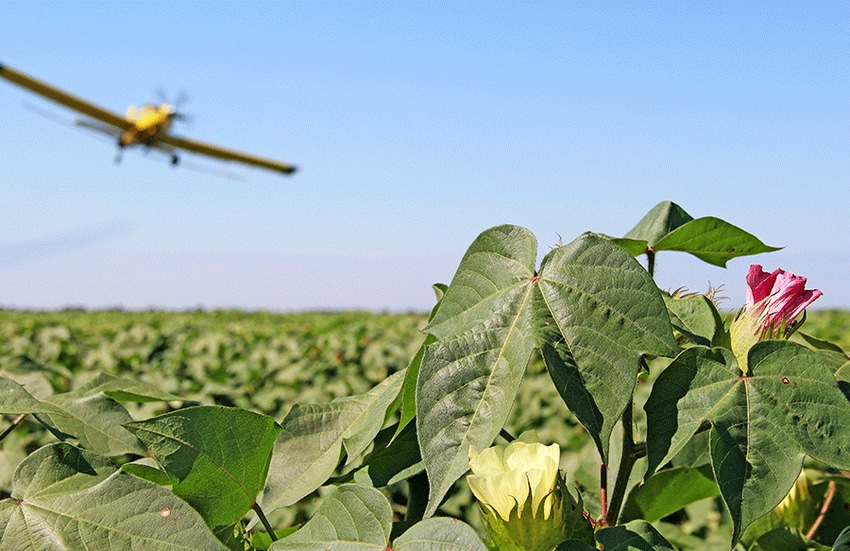
Mississippi cotton producers, as of mid-July, “are sitting in the driver’s seat with this crop,” says Darrin Dodds, state Extension cotton specialist at Mississippi State University.
While there were some spots between Clarksdale and Tunica and north of Tunica that “haven’t seen rain in forever,” and areas on the eastern part of the state north of Macon that haven’t had rain in while, he says his travels around the state indicate “potential for an outstanding crop.”
Tripp Hayes, from left, Clarksdale, Miss., producer; Justin Ferguson, national affairs coordinator/major row crops, Mississippi Farm Bureau Federation; and Kendall Garraway, Bolton, Miss., producer were among those attending the recent joint meeting of the Mississippi Boll Weevil Management Corporation and the Mississippi Farm Bureau Federation Cotton Policy Committee.
As a whole, he said at the recent joint meeting of the Mississippi Boll Weevil Management Corporation and the Mississippi Farm Bureau Federation Cotton Policy Committee, “I think most of this crop is at 18-22 nodes [as of July 19]. Some is short, some is tall, but we’re at 5 to 7 nodes above white flower right now.
“We can make a great crop with 20 to 21 node cotton, if retention is high. In 2014, we had somewhat of a short crop, but our retention numbers were up, and as a result we averaged 1,232 pounds for the state.
“I can’t tell you how many people I’ve talked with about this crop, and their overall comments are that whole plant retention is as good or better than they’ve seen in years. Some say they’ve never seen whole plant retention levels like we’re seeing right now. I talked with a farmer last night who said in 40 years he only recalls one or two times he’s seen this level of retention on the entire plant.
“With this kind of retention,” Dodds says, “even if we stopped at a 20 node crop, the yield potential would still be outstanding. If we get up to 22 to 23 nodes, and we can hold some of that additional fruit another month or so, we’ll be sitting on a very, very good crop. Then, we’ll just hope for good weather in the fall to get it out of the field.”
On the whole, he says, “It looks like this crop is shaping up to be a little bit early, and that’s nothing to complain about. From Highway 82 north, I generally think of Aug. 22 as the last day we can effectively count on putting a white bloom in the picker basket. If we’re a week earlier than that this year, and we’ve got our node counts and retention numbers right, it just means we’re going to get our pickers in the field earlier and avoid potential weather problems.
"We’ve told growers to be aggressive with their PGR applications on several varieties that are commonly grown, as they are aggressive in growth habit and can quickly get away from you. But this year, if a grower is holding 80 percent to 90 percent of the fruit on a 40” tall plant, he’s nervous. I understand that, but consider that if he’s got 20 node cotton, with absolutely outstanding retention, and five or six nodes above white flower, that’s a pretty good situation to be in.
“Just because we’re five nodes above white flower today doesn’t necessarily mean this crop is done and isn’t going to do anything else. I wouldn’t be surprised to see two or three more nodes on this crop.
“I tell producers, ‘If you’re worried about retention on shorter cotton plants, think about trying to kill plant bugs. If your rows have lapped over and the canopy is super thick, your insecticide has a harder time being driven down into the canopy, which can hinder plant bug control.”
The last two or three years, Dodds says, target spot has been widespread in cotton. “Diseases love a big, thick, rank, lush canopy — they thrive with moisture and heat. Where the canopy is a little bit open, I think we’ll see less pressure from foliar diseases. Then, when you defoliate and run your picker through the crop, it will be a lot quicker and more efficient to harvest a crop that’s not overly tall.”
From a germplasm standpoint, he says, “I’d estimate 80-plus percent of the Mississippi crop this year is Xtend cotton, with 15 percent being Enlist, particularly in areas along Hwy. 6 from Clarksdale to Batesville.
The biggest issue with this year’s crop, Dodds says, was getting it up and growing. “We started off with three or four days of really good planting, then it started raining, and a lot of residual herbicides got activated. When we got started back up and were rolling along well, the forecast was calling for rain that weekend. Some areas got rain, some didn’t, and those that didn’t went from a really good moisture situation to one where they were running out quickly.
“In a lot of areas where rain was missed, residual herbicides didn’t get activated. “That put those growers behind right out of the gate with control of Palmer amaranth and other weeds.”
About the Author(s)
You May Also Like




